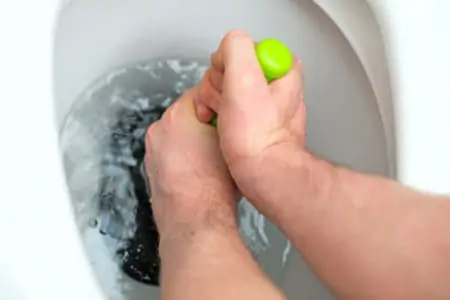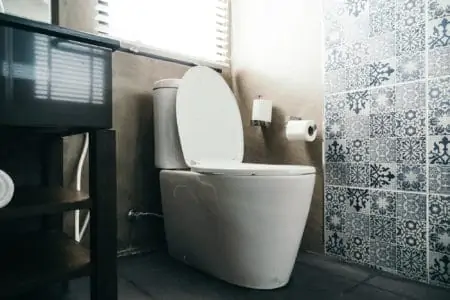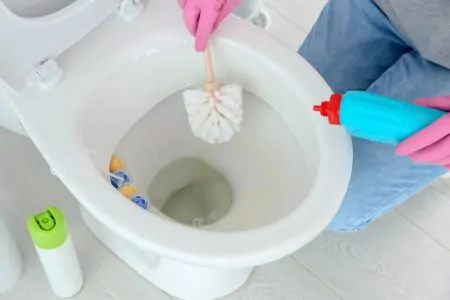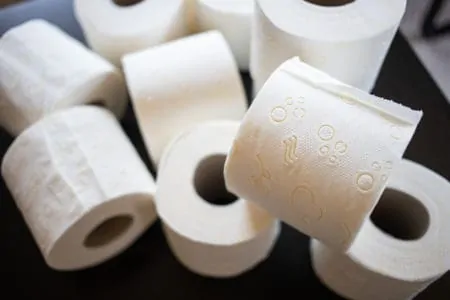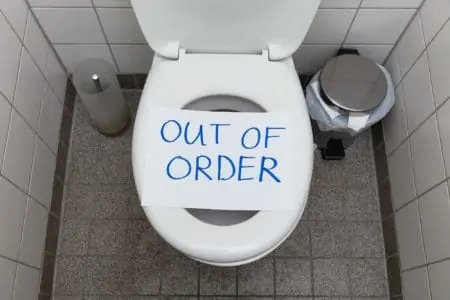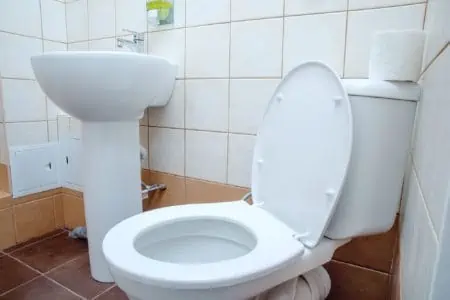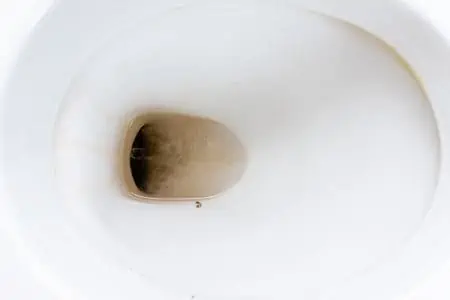Few things are as frustrating as a clogged toilet. It’s one of those jobs that most people hate, and yet if it isn’t dealt with, it could lead to more serious problems later. Learning how to unclog a toilet when nothing else works is a valuable skill that could save you money on plumber costs.
So, here is our take on how to unblock a badly clogged toilet in an easy-to-follow format with hints and tips to prevent it from clogging in the first place.
Key Takeaways
- Use less toilet paper and septic-safe toilet paper to prevent clogs.
- Keep the waste vent clear and call a professional if it’s blocked.
- Use a plunger, baking soda and vinegar, or a plumbing snake to unclog the toilet.
- Maintain cleanliness and use the right cleaning agents to avoid toilet clogs.
Why Does the Toilet Clog?
Your toilet clogs for several reasons, with some obvious and some less so. Let’s take a look at the main culprits of a blocked toilet.
Too Much Toilet Paper
Some people use handfuls of toilet paper, which is a common cause of a clogged toilet. All that paper gets pushed down the drain in a wet, claggy mass, and because the drain narrows as the waste material leaves the toilet bowl, it gets squeezed into a smaller pipe.
Try and encourage your family members to use less paper, especially the kids. Plus, Americans are obsessed with luxury triple-ply toilet tissue, which is thicker than other varieties, so consider using septic-safe toilet paper. All of these factors increase the chances of your toilet clogging.
Blocked Vent
A common cause of clogging is the air vent on your roof becoming blocked. Birds like to make nests, which reduces the amount of fresh air in the venting system. If you notice a drop in the pressure and a weaker flush, your vent could be the culprit.
If you suffer from this problem, it’s probably best that you call in the professionals, unless you have a good head for heights. We would never recommend clambering onto your roof because of the danger element.
Backed Up Waste Material
Nobody likes it when they get a clogged toilet, especially if the cause is a buildup of feces in the pipework. A great way to try and prevent this from happening is to keep the toilet bowl clean so that solid waste cannot adhere to the surface of the bowl and reduce the effectiveness of the flush.
As a precaution, you could also put a few drops of cleaning agent into the toilet each time you use it to minimize clogging.
Tree Roots
Sometimes there are external factors at play that affect the way your toilet performs. Tree roots can cause your toilet to clog because they stop the smooth flow of waste matter making its way to the sewers, making everything back up.
This is not something you can fix yourself. If you suspect that tree roots are to blame, you will need to call in professionals.
How To Unclog a Toilet When Nothing Works
Now we get to the part where we show you how to unclog that stubborn toilet blockage. So, let’s get right to it.
1. Plunger
A plunger is one of the easiest ways to shift that blockage. You’ll probably want to put on some rubber gloves to protect you against splashes.
Place the rubber cup over the toilet drain hole to create an airtight seal. Now push the plunger up and down several times to create a vacuum and then pull the plunger out quickly. This releases the clog and allows it to slide down the drain.
If the technique fails the first time, keep at it because eventually, it should work. If there is one tool you need to keep handy for emergencies, it’s a plunger.
2. Baking Soda and Vinegar
Most people have one or both of these ingredients in their kitchen, and the great news is they are both natural products and completely safe for the environment.
Drop two cups of water and one cup of baking soda into a container and mix thoroughly. Now put the solution down the toilet. The next step is to pour in two cups of vinegar and wait while the unblocker gets to work. It could take minutes or several hours.
You should see bubbles rising through the water, which is created by the reaction to the vinegar and baking soda. The baking soda and vinegar combination eats away at the blockage, and eventually, it slides down the drain.
3. Hot Water
Heat a gallon of water to just below boiling point. While you are waiting for the water to heat, squirt some dish soap into the toilet. Next, take the hot water, pour it into the toilet bowl, and leave it for a couple of minutes while it breaks up the blockage.
The combination of the dish soap and hot water should be enough to shift the clog. There are two schools of thought when it comes to pouring hot water. Some say gentle is better, while others pour the water from height to create added pressure.
Whichever way you choose is down to personal preference; just remember that if the water splashes, it could scald your skin.
4. Plumbing Snake
Plumbing snakes are easily available at most hardware and DIY stores. It is sometimes called a closet auger. Thanks to its flexible body, the snake can twist and turn in the tightest spots.
Pop on some rubber gloves to protect your hands against splashes and push the snake into the bowl, gently easing it deeper into the pipework until you meet resistance. Simultaneously push and twist the snake to force the blockage into the sewer drain. You will feel the clog give way because the snake will suddenly move freely without obstruction.
Now flush the toilet to wash away any lasting residue that might cause another buildup of waste material. To ensure all the material is gone, pour some baking soda and vinegar down the toilet.
5. Wire Coat Hanger
A wire coat hanger is a great alternative to the plumber’s snake and a lot less money. Most people have a wire coat hanger hanging in their closet. Untwist it, so the two ends come apart and then straighten it out.
Wrap the end you are sending down the toilet in a rag and cover with duct tape to prevent it from scratching the porcelain.
Insert the covered end of the coat hanger into the toilet bowl and gently ease it down into the pipework with a twisting motion. When you feel resistance, continue pushing until the coat hanger moves freely.
Now flush the toilet to remove the final remnants of the clog to stop it from happening again.
6. Enzyme Products
Enzyme waste removal products are easy to get hold of. They are sold by most hardware stores and are widely used in chemical and camping travel toilets. They work by breaking up solid matter into liquid form, so it should be an ideal solution for your toilet clog.
These enzymes are also widely used in septic tanks to disintegrate solid waste, and they are perfectly safe to use on organic waste material.
Before pouring it into your toilet bowl, read the manufacturer’s instructions to get the right amount. Leave it to work its magic on the jam, eating away at the blockage. When the water starts to drain away, you know the clog has gone.
7. Wet and Dry Vacuum Cleaner
You probably only want to try this method as a last resort because you will be extracting the waste matter and sucking it into your wet and dry vacuum cleaner, which is not ideal.
Put on rubber gloves to stop contaminated water from touching your hands and place the vacuum nozzle in the water. Switch on the vacuum and suck out all the water, leaving the blockage exposed.
Once the bowl is empty of water, stick the nozzle back into the toilet and push it gently into the drain hole. Now tie an old tea towel around the hose to help create a suction effect, switch on the vacuum, and suck out the clogged mass.
Flush the toilet to see if the water flows freely to remove any last bits of the blockage.
Ways To Prevent Your Toilet From Clogging
Before we get into clearing a clogged toilet, we thought it apt to talk about ways to prevent your toilet from clogging in the first place.
Watch What You Flush
You may be tempted to flush wet wipes and other beauty products down your toilet, but it is a one-way ticket to a clogging problem. Toilet paper is designed to break up and degrade, but wet wipes hold their form, even when flushed down the toilet.
You should only flush toilet paper and waste matter. Nothing else should go down your toilet. If you share the bathroom with other family members, ensure they know what is acceptable to flush away.
Choose the Right Flush
If you have a dual-flush model, make sure you use the correct setting, especially if you are removing solid waste and lots of toilet paper. If you use the weaker option, you risk pushing the mass part-way down the pipe, but there is not enough force to remove it entirely.
The next person to use the toilet risks adding to that mass, increasing the chances of a blockage.
Keep the Toilet Clean
Something as simple as cleaning your toilet makes a massive difference in stopping blockages. Most modern toilets are treated with surface coatings that decrease the drag when solid matter flushes down.
If you can stop waste material from adhering to the surface of the toilet, you get the most efficient flush action, which helps keep your toilet from clogging.
Top Tip
Pour a solution of baking soda and vinegar down your toilet at least once a week to prevent clogging.
Use the Right Cleaning Agent
Try and avoid caustic chemical agents because they could do more harm than good. Sure, if you have a stubborn blockage, a chemical unblocker may be an option, but only in an emergency situation.
Some powerful products can erode the seals and joints in your pipework, which weakens them. Check the labels before you use them to see if they are suitable for your toilet.
For everyday cleaning, vinegar, lemon juice, baking soda, and even hot water and dish soap are excellent ways to keep on top of your toilet cleaning regime.
